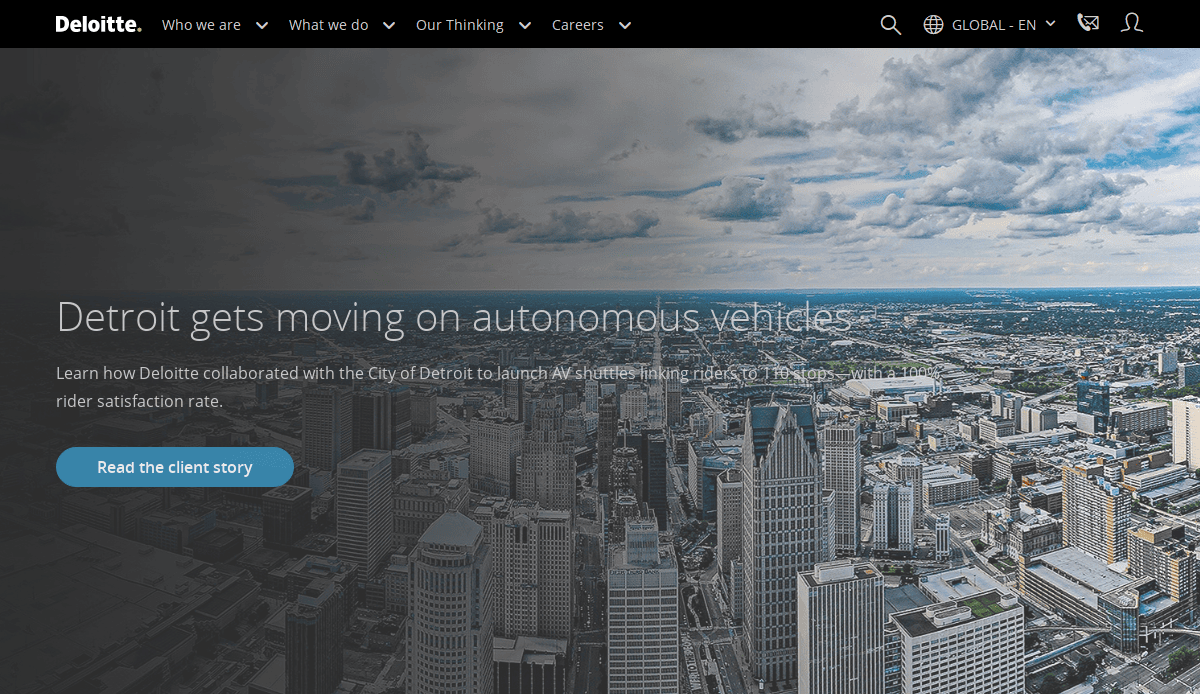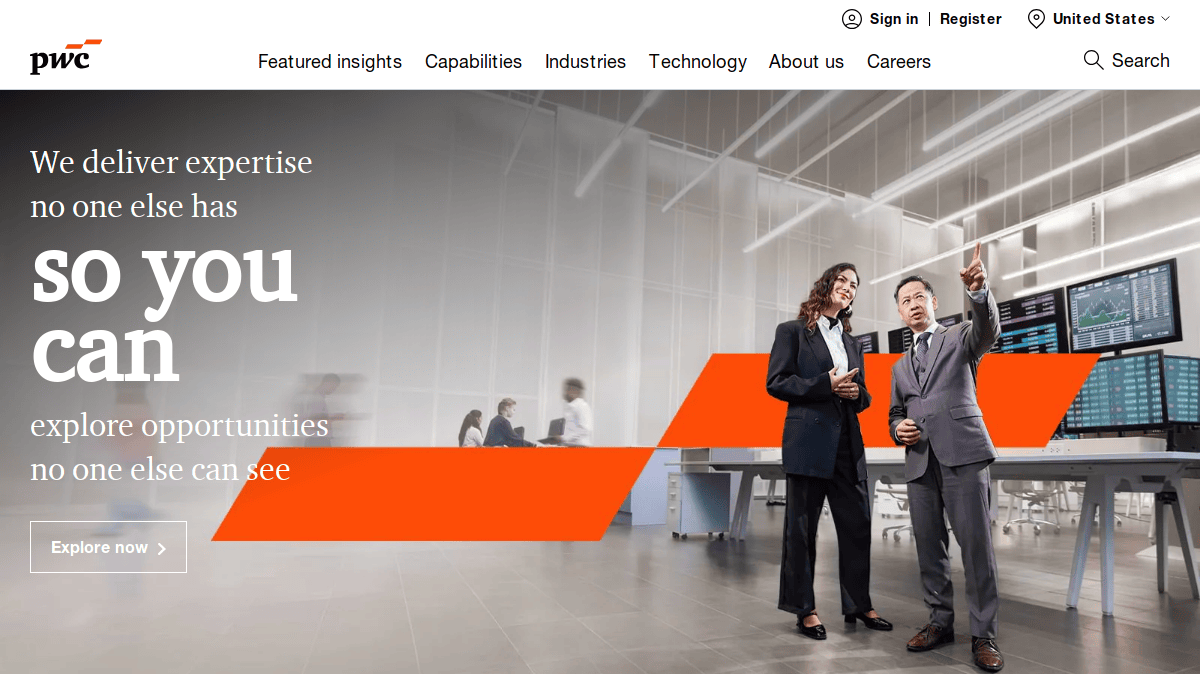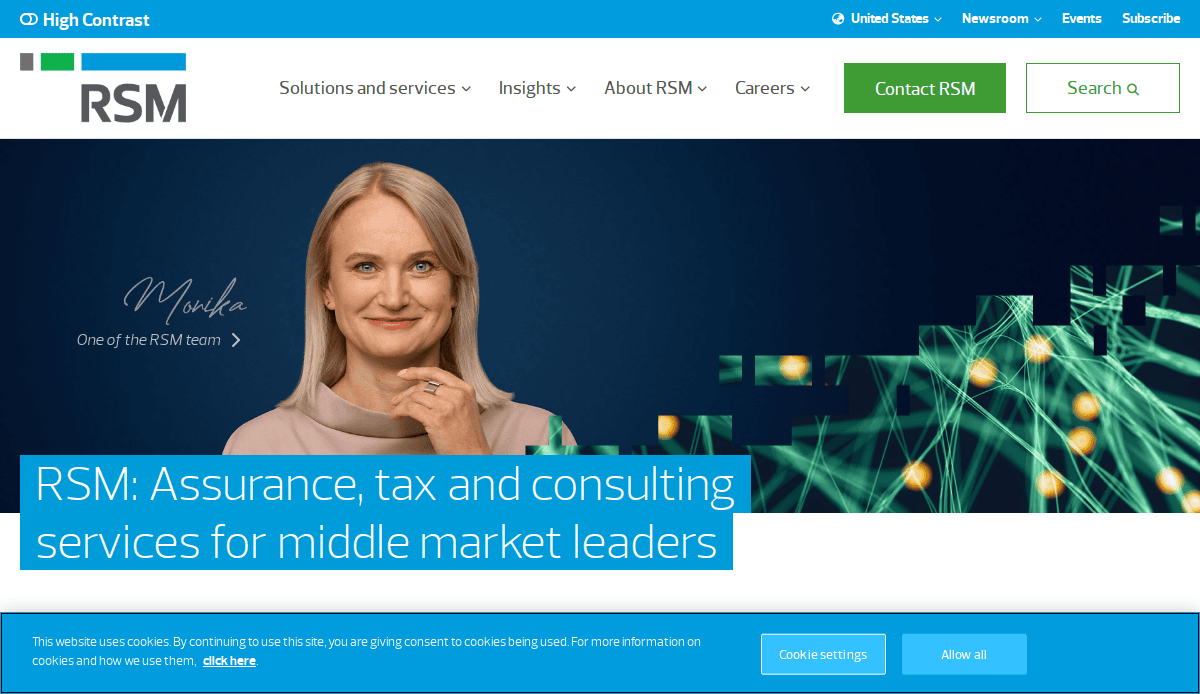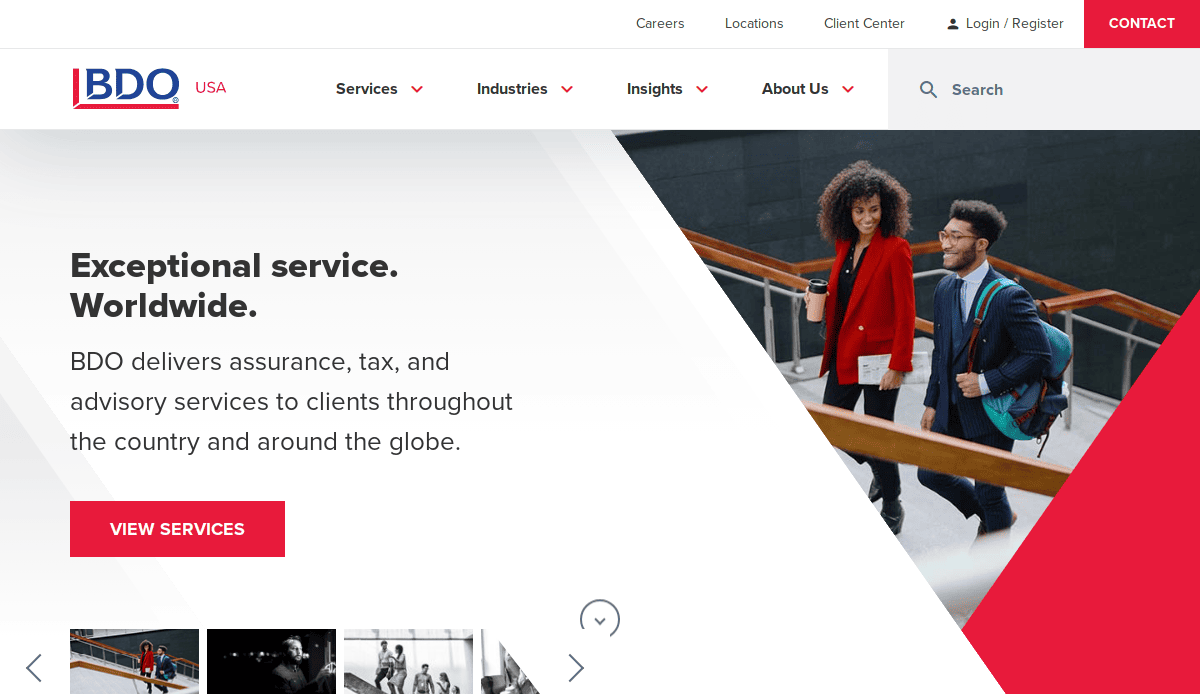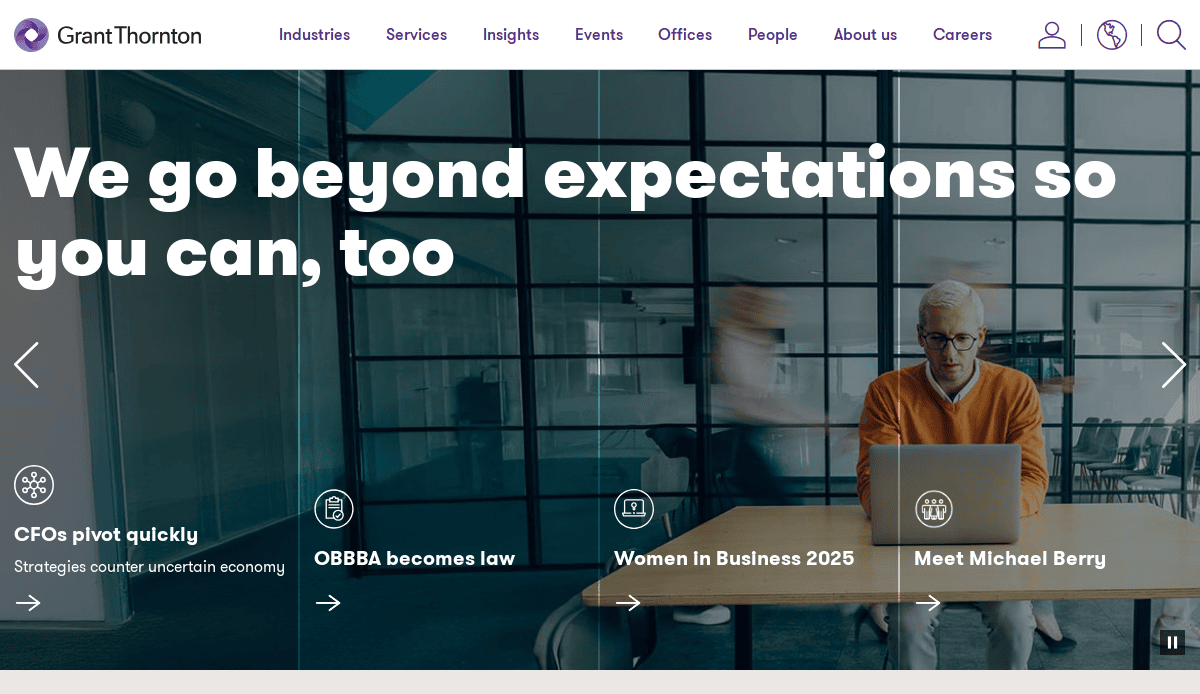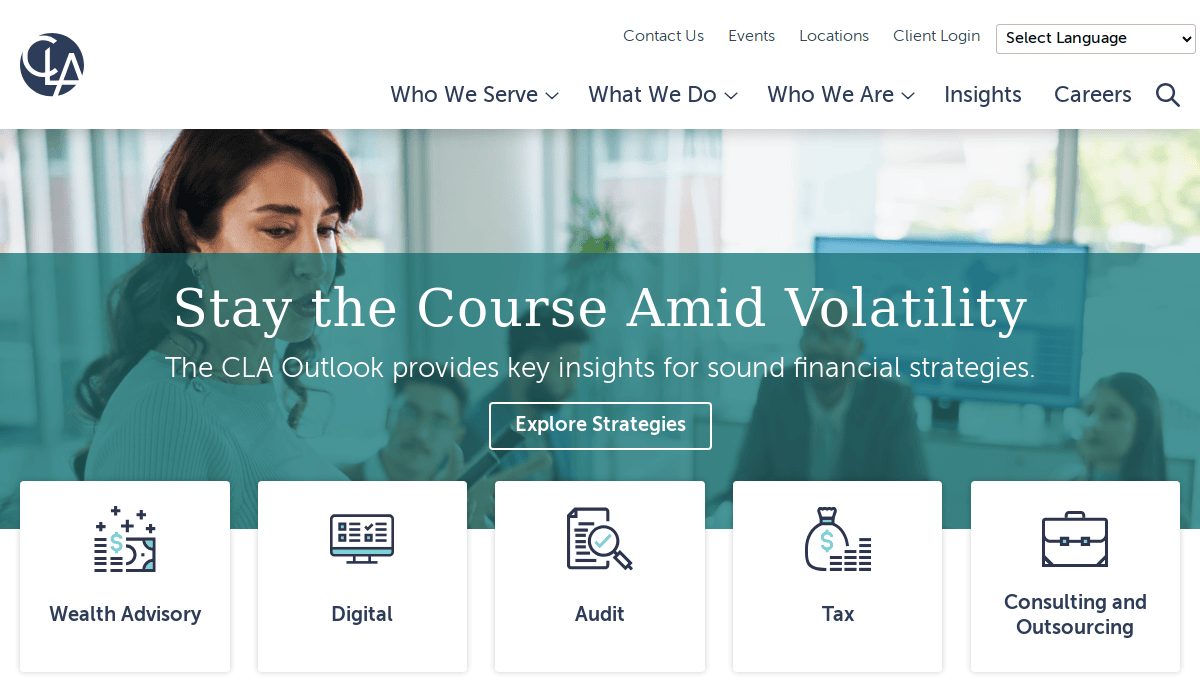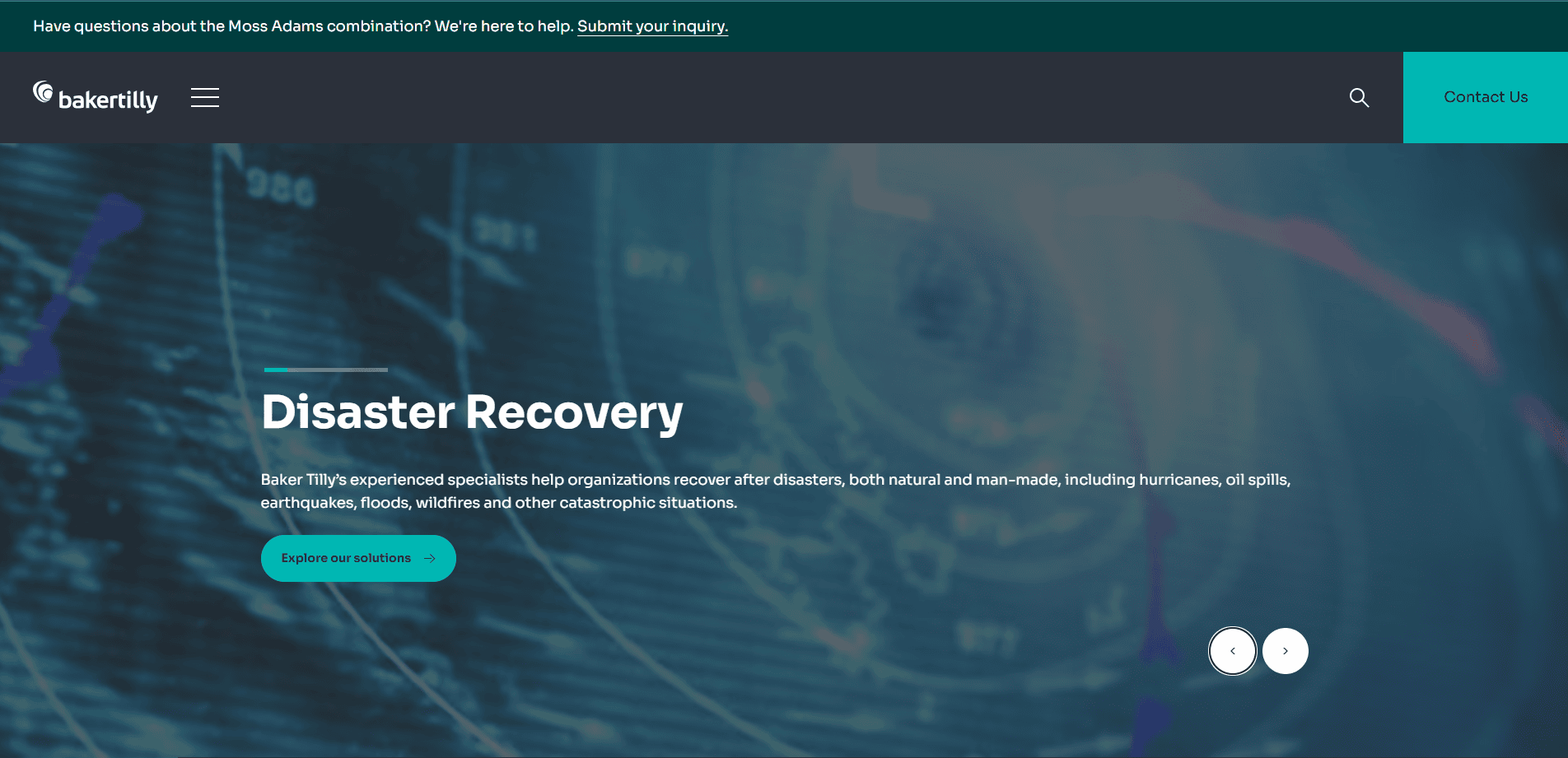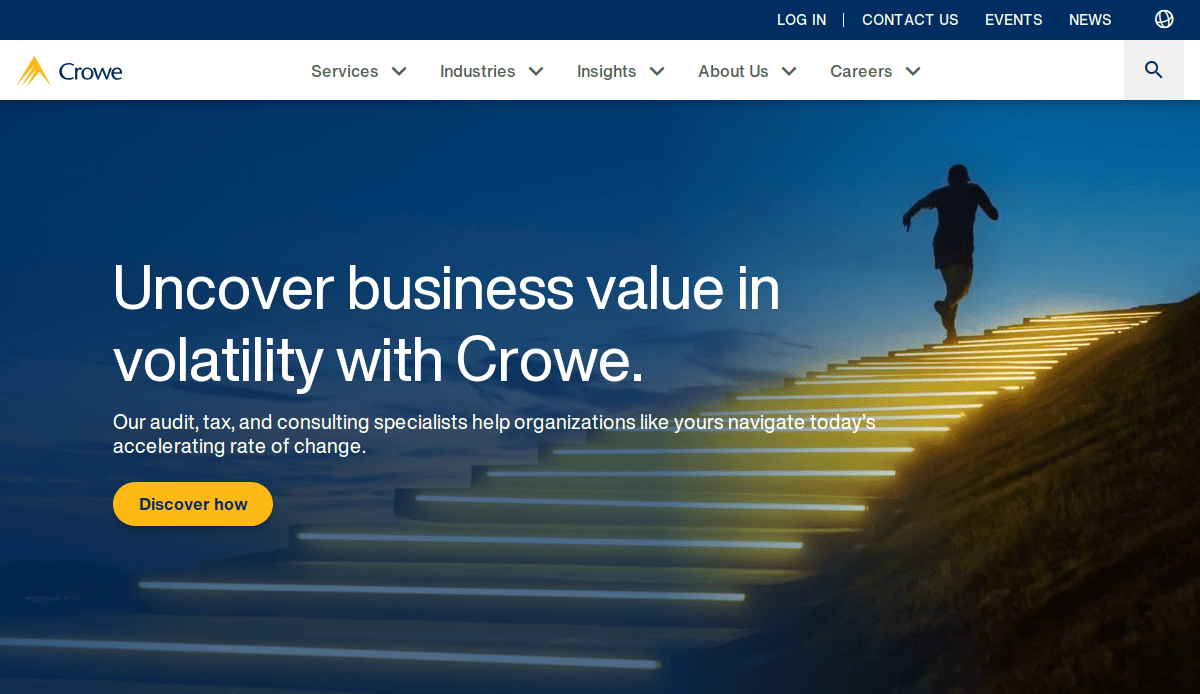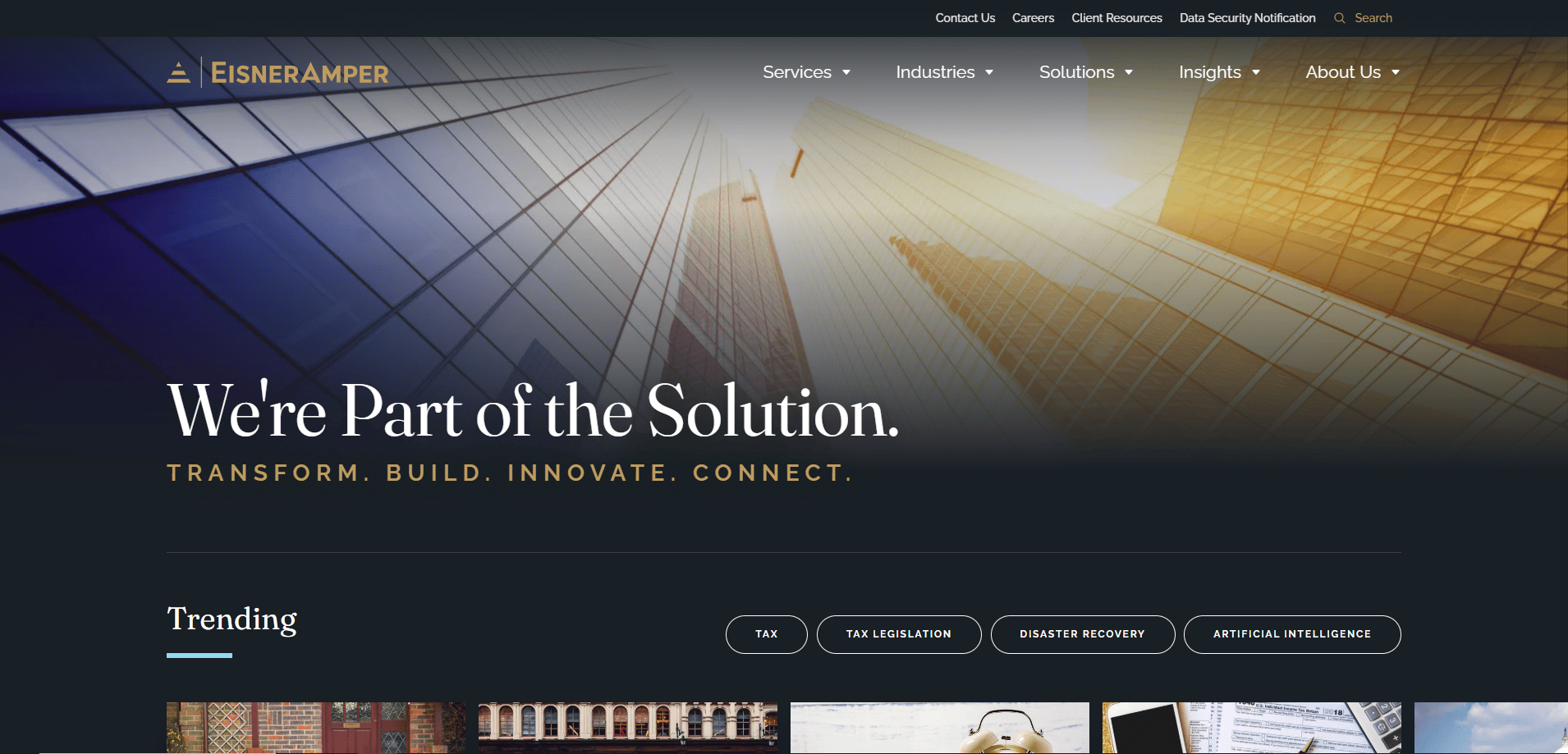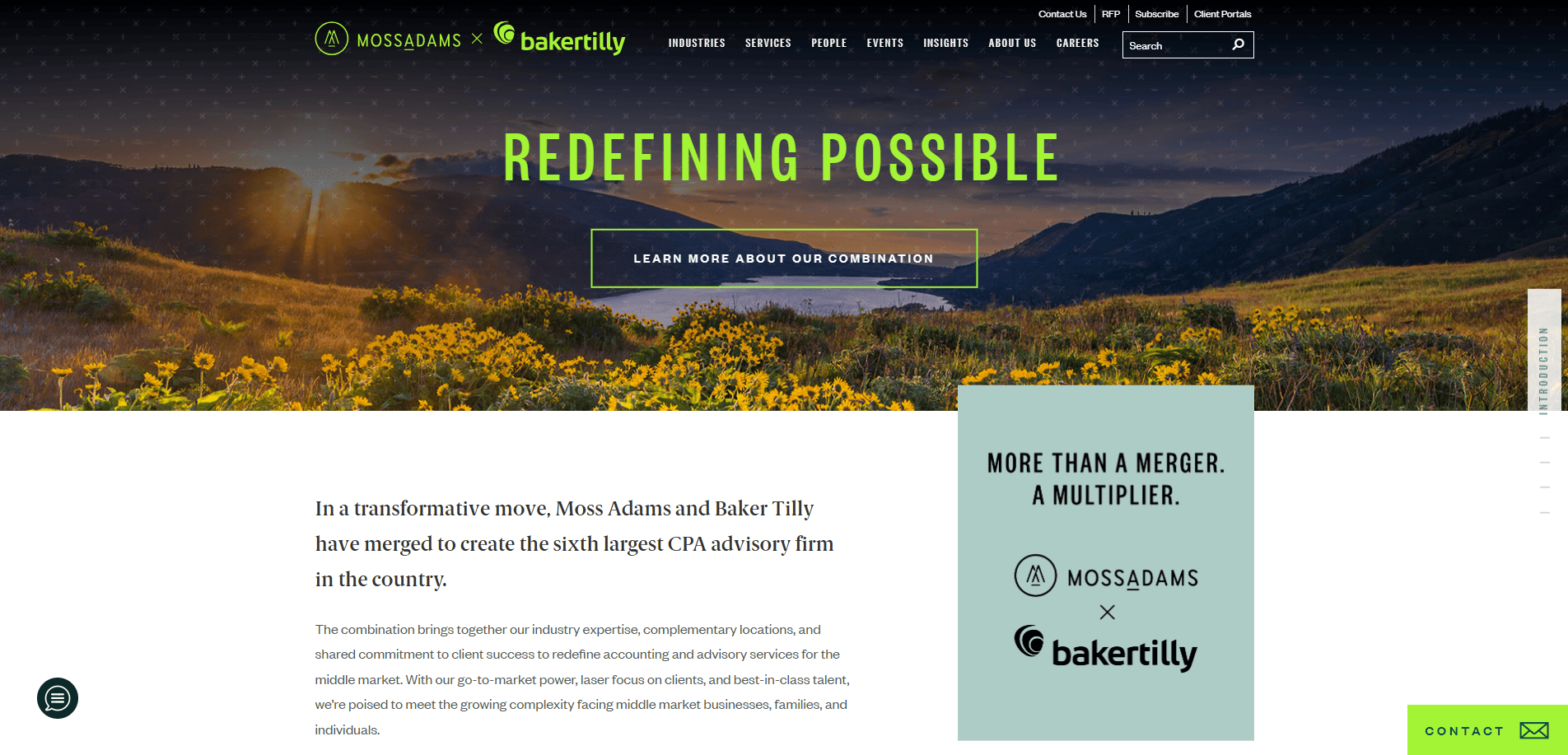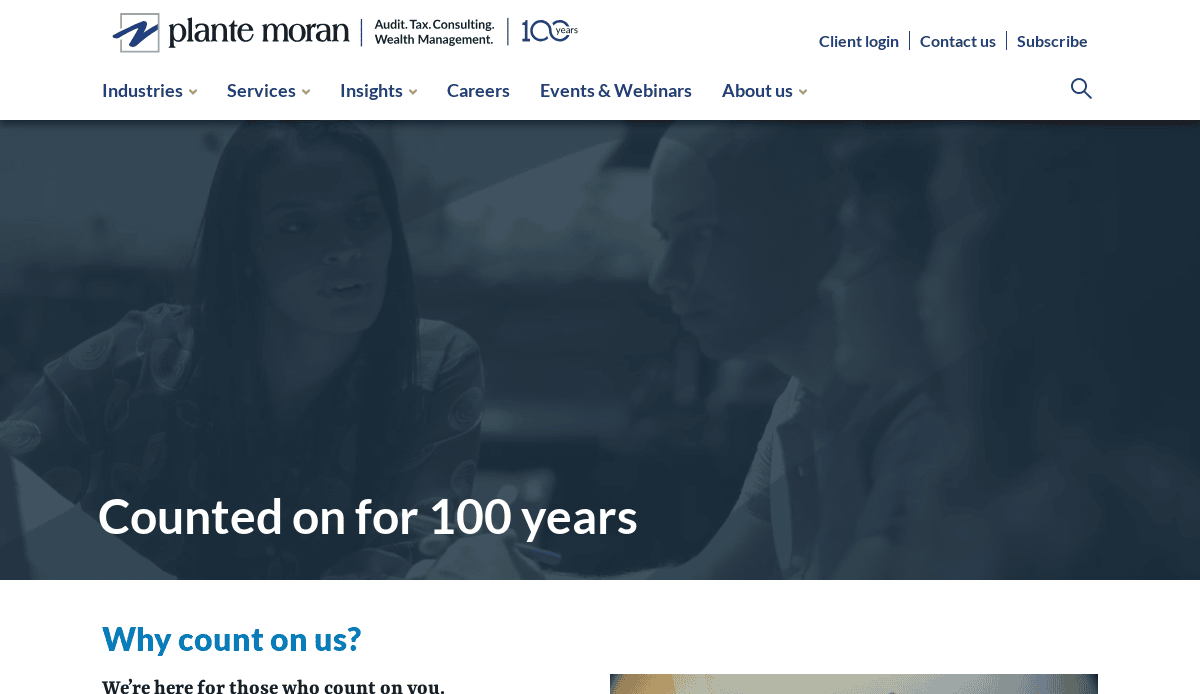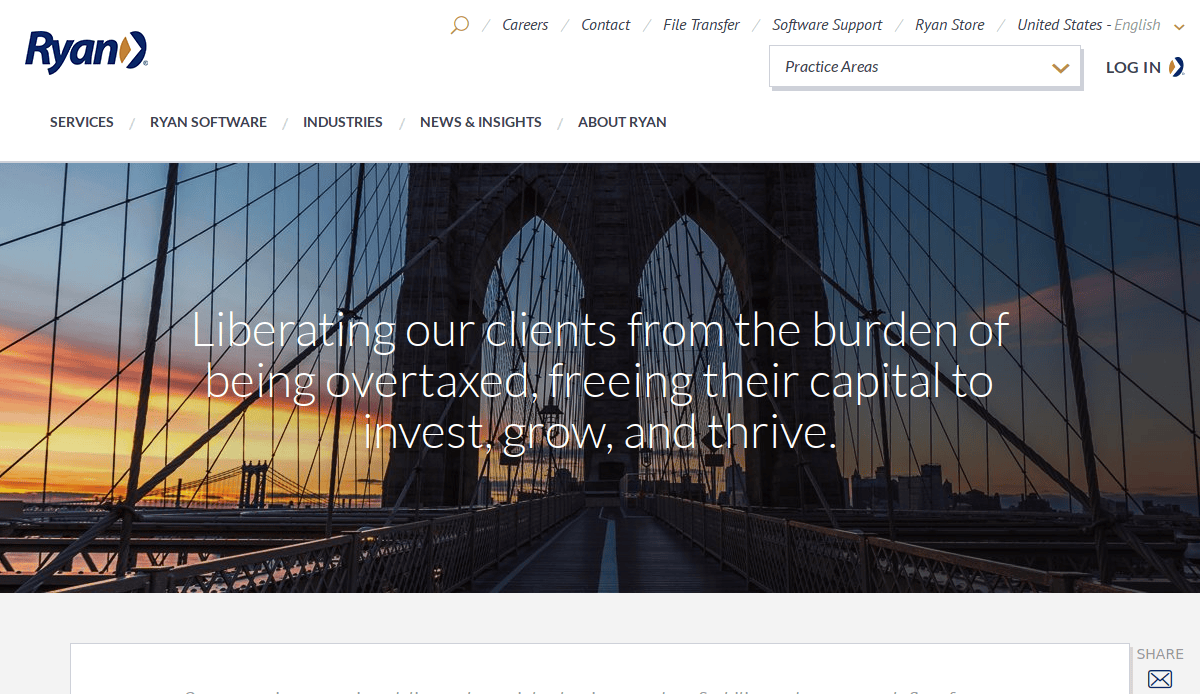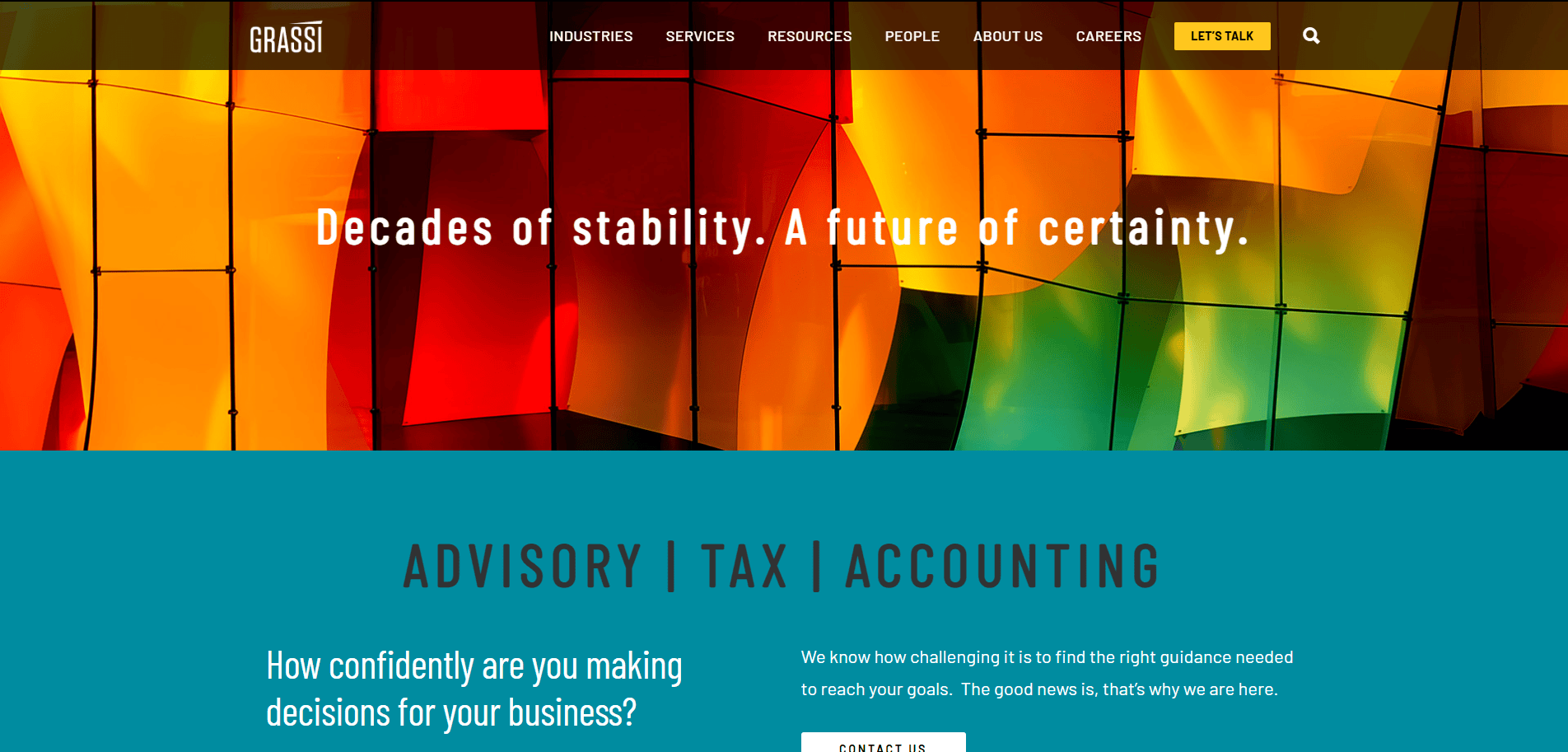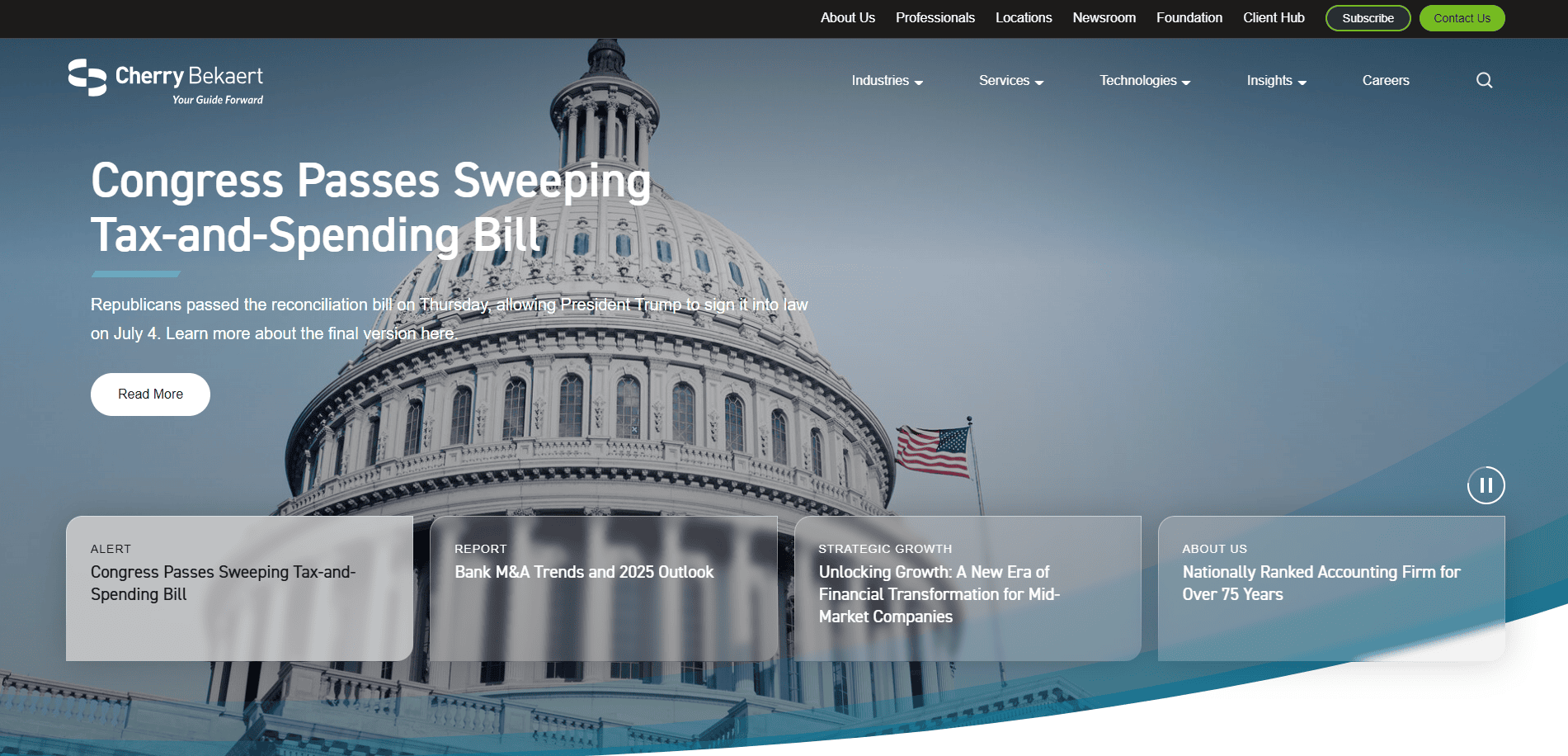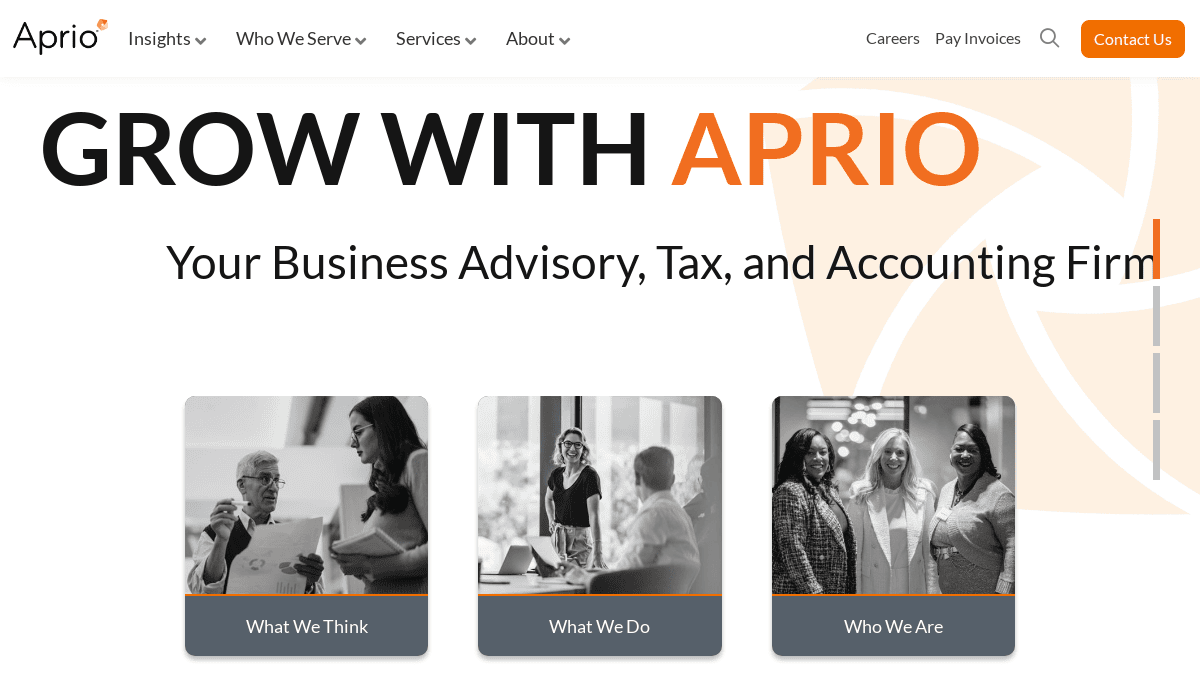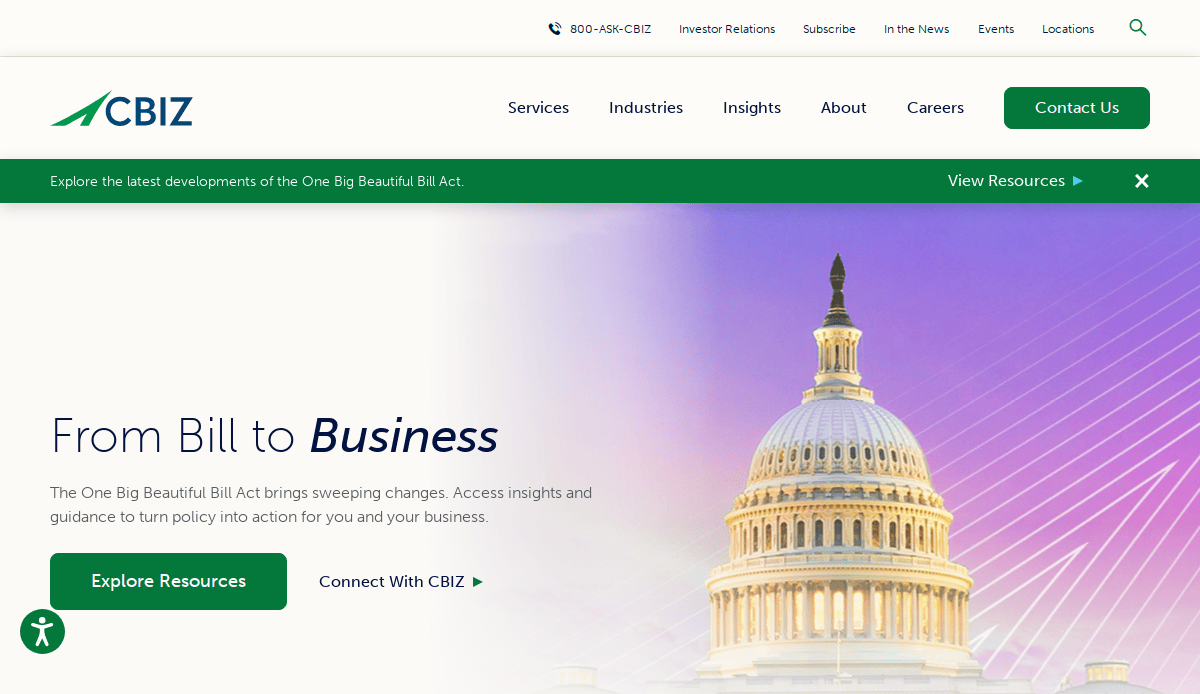Just looking for our Best Accounting Firm Website examples list?
A professionally designed website is essential for accounting firms aiming to establish trust, enhance user experience, and drive client engagement. Here are the critical elements to consider:
Key Takeaways:
- Prioritize Client-Centric Content: Focus your website content on addressing the specific needs and concerns of your clients. Clearly articulate how your services solve their problems and add value to their financial well-being. Avoid excessive self-promotion and instead highlight client benefits and outcomes.
- Incorporate Social Proof: Build credibility by showcasing testimonials, case studies, and affiliations with reputable organizations. Displaying real-life success stories and endorsements can significantly influence potential clients’ trust in your services.
- Implement Clear Calls-to-Action (CTAs): Guide visitors towards desired actions by using prominent and persuasive CTAs. Whether it’s scheduling a consultation or downloading a financial guide, clear CTAs facilitate user engagement and conversion.
Why Your Accounting Firm’s Website Design Matters More Than Ever
Now more than ever, a website is more than just a virtual business card—it’s your hardest-working marketing tool. For accounting firms and CPAs, a well-executed accounting website can make the difference between being a trusted financial advisor and being overlooked by potential clients searching online.
Whether you’re running a growing CPA firm or a boutique accounting practice, your website plays a critical role in how your brand is perceived and how effectively you convert traffic into leads. Poor design, confusing navigation, or a lack of clear calls-to-action can erode trust quickly, especially in a profession where precision, security, and clarity are non-negotiable.
This guide was created specifically to help accounting professionals build high-performing websites that reflect their expertise, attract the right audience, and deliver results. By integrating best practices in accounting website design, local SEO, and digital marketing strategy, you can create a custom website that looks great and performs across every device and search engine.
If you’ve been relying on a template that doesn’t align with your brand or failing to navigate visitors to take action, it’s time to rethink your digital presence. A modern, SEO-optimized, and conversion-focused website is essential to building authority, boosting visibility, and winning the trust of prospective clients. Let’s get this web designing party started, shall we?
Website Planning & Purpose: Laying the Foundation for a High-Performance Website
Before jumping into layout templates or visual elements, every effective website starts with one critical step: strategic planning. For accounting firms and CPAs, this phase is essential to define the purpose of your website and to ensure it becomes a lead-generating, credibility-building asset aligned with your business goals.
Define Clear Business Objectives
The first question to answer is: What do you want your website to accomplish? For most firms, this includes one or more of the following:
- Attracting new clients searching for accounting services online.
- Establishing trust and credibility through educational content and social proof.
- Supporting existing clients with resources like portals, document uploads, or scheduling tools.
- Enhancing visibility in local search results to dominate your geographic market.
By establishing specific goals—whether it’s increasing form submissions, driving more calls, or showcasing niche expertise—you’ll have a framework to evaluate every design, content, and technical decision.
Understand Your Ideal Client
Your website should speak directly to the needs of your target audience. Is your firm serving small businesses, high-net-worth individuals, or corporate tax departments? Planning content and navigation around your ideal client profile ensures relevance and engagement. This might mean emphasizing certain services on the homepage, creating separate landing pages for industries you serve, or offering downloadable resources that demonstrate your expertise.
Build a Sitemap That Guides Visitors
A clear, intuitive sitemap is the skeleton of your website. For accounting firms, common page types include:
- Home
- About the Firm
- Services (with separate pages for each service)
- Industries Served
- Meet the Team
- Testimonials or Case Studies
- Blog or Resource Center
- Contact
Planning these pages upfront ensures you don’t overwhelm visitors but instead guide them logically through your content toward a conversion.
Integrate Technical Requirements Early
Elements like mobile responsiveness, page load speed, secure hosting, and ADA accessibility shouldn’t be afterthoughts—they must be part of the initial planning process. Accounting firms handle sensitive client data and operate in a highly regulated industry, which means your website must reflect a commitment to privacy, security, and professionalism from the start.
By aligning your firm’s strategic priorities with the structure and functionality of your website during the planning phase, you set the stage for a website that performs just as well as it looks—and helps convert visitors into lasting clients.
Design Principles: What Makes a Great Design Work
Accounting firms operate in a trust-based industry. Every pixel, line of text, and design element on your website sends a message about your credibility, attention to detail, and level of professionalism. Great design isn’t just about aesthetics—it’s about creating an intuitive, reassuring user experience that supports your business goals and aligns with how your clients think and behave online.
Simplicity and Clarity
The most effective accounting websites are clean, uncluttered, and easy to navigate. Visitors should be able to find the information they need within seconds. Use whitespace strategically to direct attention to key elements like calls-to-action, and avoid overwhelming users with too many options on a single page. Clarity also extends to your messaging—avoid jargon and make your services instantly understandable to the average potential client.
Visual Hierarchy
Strong visual hierarchy guides visitors through your content in a logical, intuitive way. Use headings, subheadings, bold text, and consistent styling to prioritize what matters most. Important content—such as your key services, trust-building testimonials, or a prominent “Schedule a Consultation” button—should stand out both visually and structurally.
Brand Consistency
Accounting firms often struggle with generic design templates that don’t align with their brand voice. Your website should reinforce your identity through consistent colors, fonts, tone, and imagery. This visual consistency builds trust and helps clients associate your firm with professionalism and reliability.
Accessibility and Readability
Your accounting website should be accessible to all users, including those with visual impairments or disabilities. Use legible fonts, high-contrast colors, and alt-text for images. Ensure your layout works seamlessly on mobile devices and complies with ADA accessibility standards. An accessible site expands your reach and reflects your firm’s commitment to inclusivity and ethical best practices.
Strategic Use of Trust Signals
Trust is the foundation of any accountant-client relationship. Design your site to visually emphasize testimonials, client logos, certifications, and security badges. These design elements should be prominently placed but not intrusive—integrated naturally into your layout to reinforce confidence.
Conversion-Optimized Layouts
Design isn’t just about looking good; it’s about driving action. Every page should have a clear next step. Whether it’s contacting your firm, requesting a quote, or downloading a lead magnet, each call-to-action should be highly visible and contextually placed. Designing with conversion in mind ensures your website functions as a true business development tool.
For a breakdown of how design principles integrate into the full website process, read our step-by-step guide to the web design process.
Well-executed design builds trust, supports clarity, and guides users toward action—all essential qualities for accounting firms looking to grow online.
Content & Navigation: Structuring for Clarity and Conversion
For company websites, content and navigation are the framework that holds everything together. Even the most visually appealing site will underperform if users can’t quickly find what they’re looking for—or if the content doesn’t clearly communicate your value. In a profession built on clarity and trust, your website should reflect those same principles.
Clear, Client-Focused Messaging
The content on your site should speak directly to the needs and concerns of your target audience. Instead of focusing on firm history or internal milestones, lead with the benefits clients care about: accurate filings, proactive advice, industry-specific expertise, and peace of mind. Use plain language and organize your service descriptions in a way that’s easy to skim and understand. Include short headlines, bulleted lists, and succinct paragraphs to enhance readability.
Each page should answer the question, “What’s in it for me?” from the client’s perspective. Service pages should describe not just what you do, but how it helps—whether it’s saving time, avoiding penalties, or planning more effectively for growth.
Organized Navigation That Mirrors the Buyer Journey
Navigation should be intuitive and purpose-driven. The goal is to help users quickly locate relevant information and guide them toward taking action. A typical accounting website navigation might include:
- Home
- About
- Services(with dropdowns for Tax, Bookkeeping, Payroll, etc.)
- Industries Served(highlight niches like real estate, nonprofits, or small businesses)
- Team(bios that build trust)
- Blogor Resources
- Testimonialsor Case Studies
- Contact
Dropdown menus help keep your top-level navigation clean while offering access to detailed subpages. It’s also wise to include strategic CTAs within your nav bar, such as “Schedule a Consultation” or “Client Portal Login.”
Strategic Use of Supporting Pages
Beyond core service pages, consider content that supports SEO and builds authority. This includes blogs, FAQs, and landing pages for local SEO terms. Thoughtful, keyword-optimized content positions your firm as an expert and improves visibility in search engine results.
For inspiration and real-world examples of content structure and layout, visit our list of the 19 best accounting firm websites. These top-performing sites showcase how smart content architecture and seamless navigation work together to create a user-friendly, results-driven experience.
When planned correctly, your site’s content and navigation don’t just inform—they engage, persuade, and convert.
Visual Elements: Enhancing Trust Through Design
In the accounting industry, where professionalism, accuracy, and reliability are paramount, the visual elements of your website play a key role in communicating those values. Unlike industries where flashy or trendy visuals might dominate, accounting websites benefit most from design choices that prioritize clarity, consistency, and confidence.
Establishing Credibility Through Visual Identity
Your brand’s visual identity begins with the basics: logo, color palette, and typography. These elements should be consistent across all pages to reinforce recognition and credibility. A clean, modern layout with refined typefaces and a professional color scheme—such as navy blues, grays, or dark greens—subtly conveys stability, competence, and trustworthiness.
Strong visual branding sets your firm apart and reassures prospective clients that you’re established, detail-oriented, and dependable.
The Role of Photography and Imagery
Stock images of calculators and spreadsheets are overused and often make accounting sites feel generic or outdated. Instead, invest in authentic, high-quality photography—especially of your team. Professional headshots, office environment photos, or even behind-the-scenes glimpses help humanize your firm and foster trust.
Clients want to see the people behind the services, and showcasing real faces and team dynamics can improve engagement and establish an emotional connection from the first click.
Visual Hierarchy and Scannability
Visitors often skim a website before deciding to read further. Effective use of visual hierarchy—like bold headings, subheadings, icons, and strategically placed calls-to-action—helps users quickly find what they’re looking for. Color contrast, font sizing, and whitespace also play vital roles in making content scannable and reducing cognitive load.
Icons or simple illustrations can be used to highlight key service areas, break up text, and enhance understanding without overwhelming the design.
Mobile Optimization and Responsiveness
A modern accounting website must look and function flawlessly across all devices. Visual elements need to scale and reposition cleanly on smartphones and tablets. That means buttons should be large enough to tap, text should remain legible without zooming, and images should load quickly without slowing down the site.
With more clients researching services on mobile, responsive design is no longer optional—it’s a baseline requirement.
Reinforcing Calls-to-Action
Your visual design should always support the goal of conversion. This includes making your primary calls-to-action, such as “Request a Consultation” or “Schedule a Tax Review,” stand out with contrasting buttons and strategic placement throughout the site.
Visual consistency and clarity allow your message to come through without distraction. When thoughtfully executed, visual elements elevate the aesthetic of your accounting website, create a sense of trust, guide users smoothly through the site, and motivate them to take action.
Ongoing WordPress Maintenance: Keeping Your Site Secure and High-Performing
Launching a new website is just the beginning. For firms using WordPress, ongoing maintenance is essential to keep your site secure, optimized, and functioning at peak performance. In a field that demands accuracy, trust, and professionalism, neglecting updates or letting technical issues accumulate can quickly undermine your credibility and cost you leads.
Why Maintenance Matters for Accounting Firms
Accounting firms handle sensitive financial data and are often targeted by malicious bots or bad actors looking to exploit vulnerabilities. A compromised website doesn’t just damage your reputation—it can jeopardize client trust and lead to compliance risks. Regular maintenance ensures your site remains secure, loads quickly, and performs consistently across browsers and devices.
Beyond security, an unmaintained site can suffer from broken links, plugin conflicts, outdated content, and slow load times—all of which frustrate users and hurt your rankings in search engine results.
Core Elements of WordPress Maintenance
A reliable WordPress maintenance strategy for accountants should include:
- Core and Plugin Updates: Ensures that your site uses the latest features and security patches without compatibility issues.
- Website Backups: Daily or weekly backups safeguard your data and allow for quick recovery in case of a problem.
- Performance Optimization: Regular cleanup of databases, image compression, and speed checks help maintain a fast, responsive site.
- Security Monitoring: Firewalls, malware scanning, and real-time threat detection help prevent breaches.
- Content Review: Keeping service pages, team bios, and blog content current reflects well on your professionalism and SEO.
For example, many of the best CPA websites stand out for their design and for their ongoing freshness and reliability, key indicators that someone is actively maintaining and improving them behind the scenes.
The Value of Professional Oversight
While WordPress makes content management user-friendly, most accounting firms benefit from having a dedicated partner manage updates, security, and optimization. This ensures nothing is overlooked and gives your team time to focus on client service, not technical upkeep.
An investment in WordPress maintenance is an investment in your firm’s online reputation. It helps avoid costly downtime, protects client data, and ensures that your website continues to function as a reliable marketing tool long after launch.
Best Accounting Firm Website Examples
1. Deloitte
Location: New York, NY
Key Takeaways:
- Clean and professional design reflecting the firm’s stature.
- High-quality images and straightforward navigation.
- Well-placed CTAs facilitating user interaction.
2. PwC (PricewaterhouseCoopers)
Location: New York, NY
Key Takeaways:
- Detailed service descriptions and client testimonials.
- Homepage showcasing latest research and reports.
- Intuitive navigation and well-organized content.
3. Ernst & Young (EY)
Location: New York, NY
Key Takeaways:
- Clean and professional design reflecting entrepreneurial spirit.
- High-quality images and clear navigation.
- Dedicated pages for each industry sector.
4. KPMG
Location: New York, NY
Key Takeaways:
- Sleek and modern design emphasizing quality and integrity.
- Detailed service descriptions and client testimonials.
- Interactive elements enhancing user engagement.
5. RSM US LLP
Location: Chicago, IL
Key Takeaways:
- Clean and professional design for middle-market businesses.
- Focus on industry-specific solutions.
- Comprehensive resource center with valuable insights.
6. BDO USA
Location: Chicago, IL
Key Takeaways:
- Professional and polished design representing global leadership.
- Elegant navigation and well-organized menus.
- Interactive features increase value and accessibility.
7. Grant Thornton
Location: Chicago, IL
Key Takeaways:
- Clean and professional design serving dynamic organizations.
- Detailed service descriptions and client testimonials.
- Focus on industry-specific solutions.
8. FORVIS Mazars
Location: Kansas City, MO
Key Takeaways:
- Sleek and modern platform combining aesthetic appeal with functionality.
- Interactive service and industry pages enhancing engagement.
- Responsive design ensures seamless access across devices.
9. CLA (CliftonLarsonAllen LLP)
Location: Minneapolis, MN
Key Takeaways:
- Clean and professional design understanding clients’ goals.
- High-quality images and clear navigation.
- Focus on industry-specific solutions.
10. Baker Tilly
Location: Chicago, IL
Key Takeaways:
- Slick and professional design reflecting top advising reputation.
- Clean color scheme with white and green accents.
- User-friendly platform for businesses and clients.
11. Crowe LLP
Location: Chicago, IL
Key Takeaways:
- Clean and professional design delivering innovative solutions.
- Extensive usage of call-to-action buttons improving user experience.
- Interactive elements enhancing user engagement.
12. Amper
Location: New York, NY
Key Takeaways:
- Sophisticated design simplifying a wide array of services.
- Emphasis on corporate-grade photography and balanced color scheme.
- Timely articles and industry reports aligning visual appeal with valuable content.
13. Moss Adams
Location: Seattle, WA
Key Takeaways:
- Crisp visuals and prominent navigation bar establishing immediate trust.
- Uncluttered layout guiding prospective clients toward key areas.
- Dynamic content blocks offer seamless access to insights.
14. Plante Moran
Location: Southfield, MI
Key Takeaways:
- Emphasis on culture and client-first service model.
- Professional layout with clear navigation.
- Comprehensive services including audit, tax, and consulting.
15. Ryan LLC
Location: Dallas, TX
Key Takeaways:
- Sleek design showcasing tax services and consulting expertise.
- Clear calls-to-action guiding user interaction.
- Global presence with user-friendly interface.
16. Grassi & Co.
Location: Jericho, NY
Key Takeaways:
- Employee-owned firm emphasizing advisory, tax, and accounting services.
- Professional design with clear service descriptions.
- Focus on various industries including healthcare and technology.
17. Cherry Bekaert
Location: Raleigh, NC
Key Takeaways:
- Professional services firm with assurance, consulting, and tax services.
- Clean design reflecting the firm’s history and expertise.
- User-friendly navigation and informative content.
18. Aprio
Location: Atlanta, GA
Key Takeaways:
- Accounting and business advisory firm with global reach.
- Modern design showcasing diverse services.
- Emphasis on innovation and client success.
19. Marcum LLP
Location: New York, NY
Key Takeaways:
- Provides a wide range of services, including tax, assurance, and advisory, catering to various industries and client needs.
- Features intuitive navigation and a clean layout, making it easy for visitors to find information and resources.
- Regularly publishes insightful articles and reports, positioning the firm as a knowledgeable leader in the accounting industry.
These design principles align with best practices in accounting website development, aiming to build trust and credibility with potential clients.
Ready to Build a Website That Reflects Your Firm’s Credibility?
A well-planned, professionally executed website isn’t just a marketing asset—it’s a critical part of how clients perceive your brand. Whether you’re offering advisory services, financial services, or tax prep, the design and development of your website can set the tone for trust, professionalism, and long-term growth. From clean design to strategic navigation, modern design principles and SEO-friendly content will help differentiate your firm and generate quality leads for your firm.
As a full-service digital marketing agency, we specialize in web design services tailored specifically for accounting firms of all sizes. We understand how to transform a static site into an engaging website that supports your goals, reflects your values, and works seamlessly with your marketing efforts.
Need a website that earns trust and converts visitors into clients? Request a free consultation with our WordPress web design experts and let’s build your accounting website the right way.
Frequently Asked Questions: Accounting Firm Website Design
1. What makes an effective accounting website design?
An effective accounting website design is built around trust, clarity, and conversion. It features intuitive navigation, clear messaging, strong calls-to-action, and mobile responsiveness. It should also highlight your top-notch financial services, demonstrate expertise, and direct visitors toward scheduling consultations or requesting quotes. Including trust signals like testimonials, certifications, and secure website elements reinforces credibility.
2. Should I use a website builder or hire a professional agency?
While website builders offer convenience and cost savings, many accounting firms outgrow these platforms quickly. A professional web design agency like ours ensures your site is customized, optimized for SEO, integrated with accounting software if needed, and scalable as your business grows. If you’re serious about establishing your firm and standing out from the competition, a custom solution is usually the better investment.
3. How do I structure the content on a website for my accounting firm?
Follow a content structure that addresses your target audience’s needs. Include pages for each of your services, an About page to humanize your team, a Blog or Resources section to position your firm as a thought leader, and a clear Contact page. Be sure to include keyword-optimized headlines and service descriptions.
4. How important is website security for accounting websites?
Website security is critical for accounting businesses, especially those offering advisory services or integrating portals for client document exchange. A secure website protects sensitive client information and preserves your firm’s reputation. Be sure your site uses HTTPS, secure forms, regular backups, and protection against spam or malware. Website security should never be an afterthought in your website’s design.
5. How can a website help generate leads for my firm?
An effective website can attract and convert visitors through SEO, persuasive copy, and strong calls-to-action. Your website should function as a lead engine by addressing client concerns, offering downloadable resources or guides for accounting, and making it easy for users to reach out. Sites that adhere to best practices—like fast loading times, mobile optimization, and engaging content—convert more website visitors into leads.
6. Can I integrate my website with accounting software?
Yes, a well-built website can integrate with accounting software to streamline client management and reporting. Whether it’s QuickBooks integration, client portals, or scheduling tools, integrations improve the user experience and support your internal workflows. Be sure your development partner understands both web design for accounting and the tools your firm uses.
7. What are some design tips for CPA website design?
Design tips for CPA website design include:
- Use clean layouts and whitespace to promote readability.
- Feature real team photos instead of stock imagery.
- Incorporate trust signals like AICPA logos or testimonials.
- Ensure your site is responsive and accessible.
- Include high-contrast calls-to-action on every page.
These tips are essential for building a user-friendly website that performs well across devices and earns trust.
8. How often should I update my accounting firm’s website?
Websites for accounting firms should be updated regularly to reflect changes in services, tax law updates, team changes, or new blog content. Keeping your content fresh signals to search engines that your firm is active and authoritative. Consistent updates help establish your firm as a thought leader while improving your visibility in local search results for accounting services in your area.
9. Can my firm rank higher in search results with a better website?
Absolutely. A strong website with optimized content, fast loading speeds, proper SEO, and a responsive design significantly improves your chances of ranking for competitive search terms. Combine that with strategic content marketing and local SEO efforts to attract clients actively searching for accounting services in your area.
10. What does the ultimate guide to accounting website design include?
The ultimate guide should cover all aspects of building and maintaining a successful accounting website—planning, design tips, SEO strategies, content organization, website security, and conversion best practices. It should address the needs of accounting firms of all sizes and help you differentiate your firm in a competitive market.

